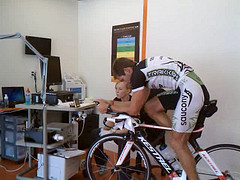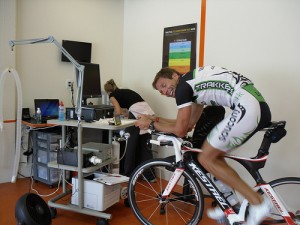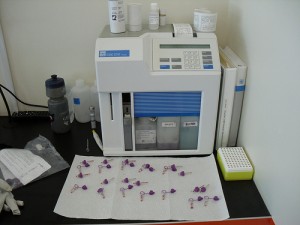Almost 10 years ago, I performed my first metabolic test under the direction of a physiology professor as I learned the details behind a metabolic assessment. After performing hundreds of tests, working with athletes from fitness enthusiasts to elites and professionals while earning two degrees, I can now truly appreciate the patterns, unique characteristics and wealth of information contained within an individual athlete’s test data.
VO2 max and blood lactate assessments are the gold standard for measuring endurance sport fitness and ability in the laboratory and help both the athlete and coach evaluate potential performance and monitor training to determine where performance can be improved. However, in order to realize true physiological gain and improve race performance, the testing data should be integrated into the athletes training program. Along with real life data, such as race power files and training feedback, the athletes testing data will help them understand physiological limitations and how to improve their metabolic responses to their specific event. Measuring changes by retesting the athletes Vo2 and or blood lactate, reveals improvements within the aerobic and anaerobic energy system continuum.
A visit from Michael Lovato
On July 22nd I had the great honor of testing a professional triathlete at the top of his game. Michael’s athletic accolades include 2 Ironman wins, several top three Ironman finishes and three ninth place finishes at the Ironman Hawaii World Championships.
What is Lactic Acid?
Lactic acid is constantly being produced in small amounts in our bodies as a byproduct of anaerobic carbohydrate metabolism (breakdown of carbohydrates for exercise fuel in the absence of oxygen). Lactic acid can also serves as a fuel for aerobic metabolism (uses oxygen), which is primarily our fat burning system. As we increase exercise intensity, more and more lactate is produced, but we can reuse the lactate as quickly as it’s being produced up to a point so that it does not accumulate and the effort is sustainable.
However, as exercise intensity increases even more, the body relies more and more on the anaerobic glycolysis system to provide every quicker energy and lactate is produced at an even higher rate. Increases in hydrogen ions cause the blood to become more acidic (pH is going down) forcing the muscles and the body to slow down.
Lactate is released by the muscles into bloodstream so blood lactate can be measured in blood samples.
Why should Michael get tested?
Michael trains with a power tap on his bike and was interested in determining his lactate profile to better understand how to train at specific wattage’s to improve his sustainable power and ultimately his performance in triathlons.
From Michael’s most recent race power profile we had an idea of what wattage’s he could sustain. Understanding his Lactate profile would help him determine where he can push training intervals in order to increase his present overall wattage average for 112 miles in an Ironman triathlon.
Testing procedure
When Michael arrived, I asked him how he felt and he said he was ready to go! This would be his first workout of the day and the day prior was easy enough so that he could recover and feel fresh for his test.
Most athletes are nervous at the thought of getting blood drawn but it is actually a very simple finger prick with a quick collection of a small amount of blood. The sampling did not seem to bother Michael.
Michael used his own bike on the Cyclops Power Beam Pro Trainer so that he was comfortable, fit correctly and we could get accurate wattage readings. After he warmed up, I took a baseline blood sample from from Michael’s finger and we agreed he was ready to start the test protocol. The protocol was a 20 watt increase in power output starting at 190 watts and increasing wattage every 3 min. At the end of every 3 min, we continued taking samples to allow for lactate levels to stabilize following each wattage increase.
During the test, Michael relayed to me his Rating of Perceived Exertion (RPE) on a scale of 1-10 to describe how hard the effort felt. Throughout most of the test, Micheal called out “2-3” which was very easy. When he started working harder, he quickly reached a “7” which equates to “Very Hard” and is usually close to the athlete’s lactate threshold. Once we saw lactate readings beyond 6.0 mmol and above his “Very, Very Hard” perceived effort, the test was stopped.
The Results
At the conclusion of the test, Michael did an easy cool down, as I entered his lactate data into a spreadsheet to display his results. The results show his blood lactate levels versus power output and heart rate. Based on the wattage and heart rate at lactate threshold, we determined power and heart rate training zones for Michael. Since we know at which wattage’s Michael will continue to clear lactate we can prescribe appropriate intensities for optimal training and racing.
Michael is obviously an exceptional athlete but all levels of fitness can be measured and the lab testing data is not just for those who are above-average fitness. Testing is a very precise way to determine unique and specific training zones for an individual. Everyone has different metabolic and lactate responses. Revealing one’s physiological profile via testing provides the individual with an accurate and reliable training tool to help realize one’s true potential.





